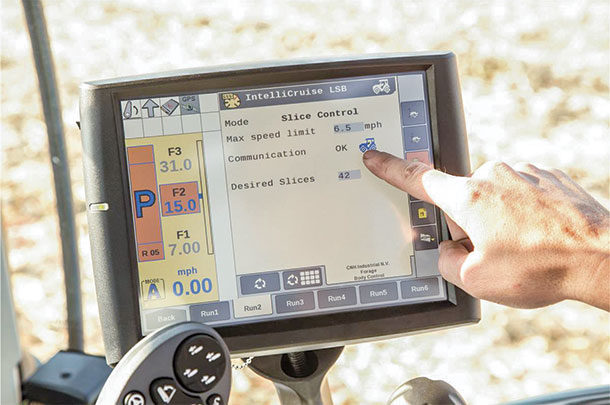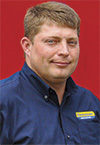We spend a lot of time and energy talking about how precision farming helps us to work the land, sow the right plant populations and meter our fertilizer to reduce costs. And yes, those tasks are critical to a bountiful harvest and responsible land stewardship, but precision-farming solutions are not exclusive to them.
First, let’s dispel a major misconception: the notion that precision farming for haymaking is all about taking the operator out of the equation – or as I often hear producers say, “taking the fun out of haymaking.” Many recent precision-farming developments have been improvements in automation that allow producers to focus on more than just driving the tractor or self-propelled windrower straight.
I consider myself a fairly accomplished machine operator. My first opportunity to operate a fully equipped machine with precision-farming auto guidance was a tractor paired with a triple-mounted mower-conditioner. I looked out proudly across the freshly mown alfalfa field, one half mown freehand, the other mown with auto guidance.
I was quickly humbled. I could see clearly that I was a good operator, but I could never match the auto guidance performance or accuracy. Using the precision-farming, auto guidance-equipped tractor did not mean I was a poor machine operator. It meant that with auto guidance, I was an even better operator.
With auto guidance, I was able to fully utilize and maintain the width of cut, pass to pass. That was the first game changer for me. I realized that without auto guidance, I was averaging a 1-foot overlap on every pass. That meant on every 28th pass, I was essentially wasting the full width of the machine I was operating.
I thought about how much time auto guidance would potentially save each day, each cut and each harvest year. Time was only the first revelation; others were fuel savings, reduced machine wear and the possibility of increased yield.
I had been running just ahead of a hungry self-propelled forage harvester that day, and in short order, the tractor and windrow merger arrived. I decided to watch the merger work for a little while first in the auto guidance mown area before moving on to the freehand area. It was impressive to see the windrow merger go on those long, laser-straight windrows, building smooth, well-formed rows for the harvester.
The operator could simply follow my tracks and go. The merger heads lined up perfectly with the windrows, and the crop was swiftly and evenly moved into a uniform, merged windrow. The windrow merger then moved into the freehand area. The first thing I noticed was the operator slowing down.
While my freehand windrows were relatively straight, they were not auto-guidance straight. It was clear the merger operator had to pay close attention to track with the mower. With less constant mown overlap between passes, the merger would occasionally catch the edge of an adjacent windrow, pulling a slug onto the belt, then depositing it into the windrow.
Then it hit me: Not only had I slowed the merger down, but I was also responsible for the little surprises for the chopper operator that might slow it down too.
My second key takeaway that day was that no matter what follows in the field, precision farming applied to haymaking can make the entire operation more streamlined and efficient. It doesn’t matter if it’s a tedder, rake, merger, baler or harvester. The entire process becomes instantly faster, easier and more productive.
As for the second part of the misconception, I still had plenty of fun mowing hay with auto guidance. The reality was that while running auto guidance, I was a lot more relaxed. I was able to mow faster, improving my productivity with less effort. For the first time, I was truly free to enjoy the hay-making process. I was better able to monitor the tractor and mowers and to look for obstructions.
I could easily see that mowing more acres in the same amount of time was not only possible with auto guidance, but I could also mow longer with less fatigue than freehand. I would imagine the windrow merger and chopper operators felt the same way.
When it comes to precision-farming benefits that trickle down through the hay-making process, one of the most notable items is swath consistency. Take, for example, a conversation I had with a producer in Wyoming some years ago while visiting his farm. The producer operates a self-propelled windrower and found the biggest advantage to be that the crop dried more evenly and seemed to produce big bales more uniformly.
The producer noted that managing overlap pass-to-pass in a constant alfalfa stand resulted in greater crop volume constancy. Put simply, the crop dried evenly, and the constant crop volume helped in the baling process.
Looking beyond simple pass-to-pass accuracy, there are other reasons to look at precision hay-making solutions. A recent paper published by Dr. Dan Undersander, professor of agronomy at University of Wisconsin, noted hayfield wheel traffic contributes to lower hay yields. In the paper, Undersander discusses physical plant damage, soil compaction and timing as the contributing factors.
When it comes to physical plant damage, Undersander says, “Wheel traffic damage to alfalfa crowns may result in cracking or breakage of the crown, which will reduce the shoots produced and may allow entry of disease.” Essentially, what he found was that damaging the crown means less production and a potential increase in disease risk.
One less pass could mean a lot less plant damage and the potential for higher yields. The complete paper is available by visiting the University of Wisconsin Forage Research and Extension.
When it comes to haymaking and precision farming, it’s easy to think it’s all about cutting and auto guidance. Today, precision farming has come a very long way from the basic assisted-steering solutions introduced years ago. The future of precision-farming technology is automation, but that doesn’t mean there is no place in the cab for an operator.
It simply means the operator can work more quickly, more accurately and with less fatigue.
Today’s precision-farming solutions are using the latest ISOBUS technology for more than just sharing a communication network and common display. ISOBUS technology has also provided a common communication platform between tractors and implements, even those of different brands. ISOBUS Class III technology is a huge step forward for precision farming, making it possible for implements to take control of the tractor, based on sensing conditions that help to ensure highly productive harvesting.
One example is a feed rate control system that allows a large square baler to control the speed of tractors based on the volume of crop in the windrow. The tractor will automatically speed up in light windrows and in heavy windrows slow down to maintain the target capacity set by the operator. This precision-farming technology allows producers to maximize throughput with up to 9 percent more tons per hour baled than standard operation.
Like auto guidance, operator intervention is reduced, which means less operator fatigue and increased productivity. The automation of tractor and baler ground speeds can also reduce extreme working loads on important components, which can aid in longer machine life.
Similarly, new technology for round balers allows the baler to control the tractor’s forward motion. It brings the tractor to a stop when the preset bale diameter has been reached, wraps the bale, and raises and closes the tailgate when the bale has been ejected. It then gives the operator a signal to cycle the forward-neutral-reverse lever forward and back to neutral to continue baling.
Triggered by bale diameter, the automated process does not depend on the operator’s reaction time. This results in more consistent cycle times that improve harvest productivity, lessen operator fatigue and reduce fuel consumption.
Modern haymaking is being driven by the practical application of current technology and the development of new technology, and precision farming is leading the way. Precision farming drives improvement across the entire hay-making operation, adding up to a healthier harvest while lessening fatigue and lowering operating costs.
Developing these and other new technologies still on the horizon is sure to bring limitless opportunities to future hay-making operations. ![]()
PHOTO: Recent precision farming developments include improvements in automation that allow producers to focus on more than just driving the tractor or self-propelled windrower straight. Photo provided by Jordan Milewski.
Jordan J. Milewski is a brand marketing manager with New Holland North America.











